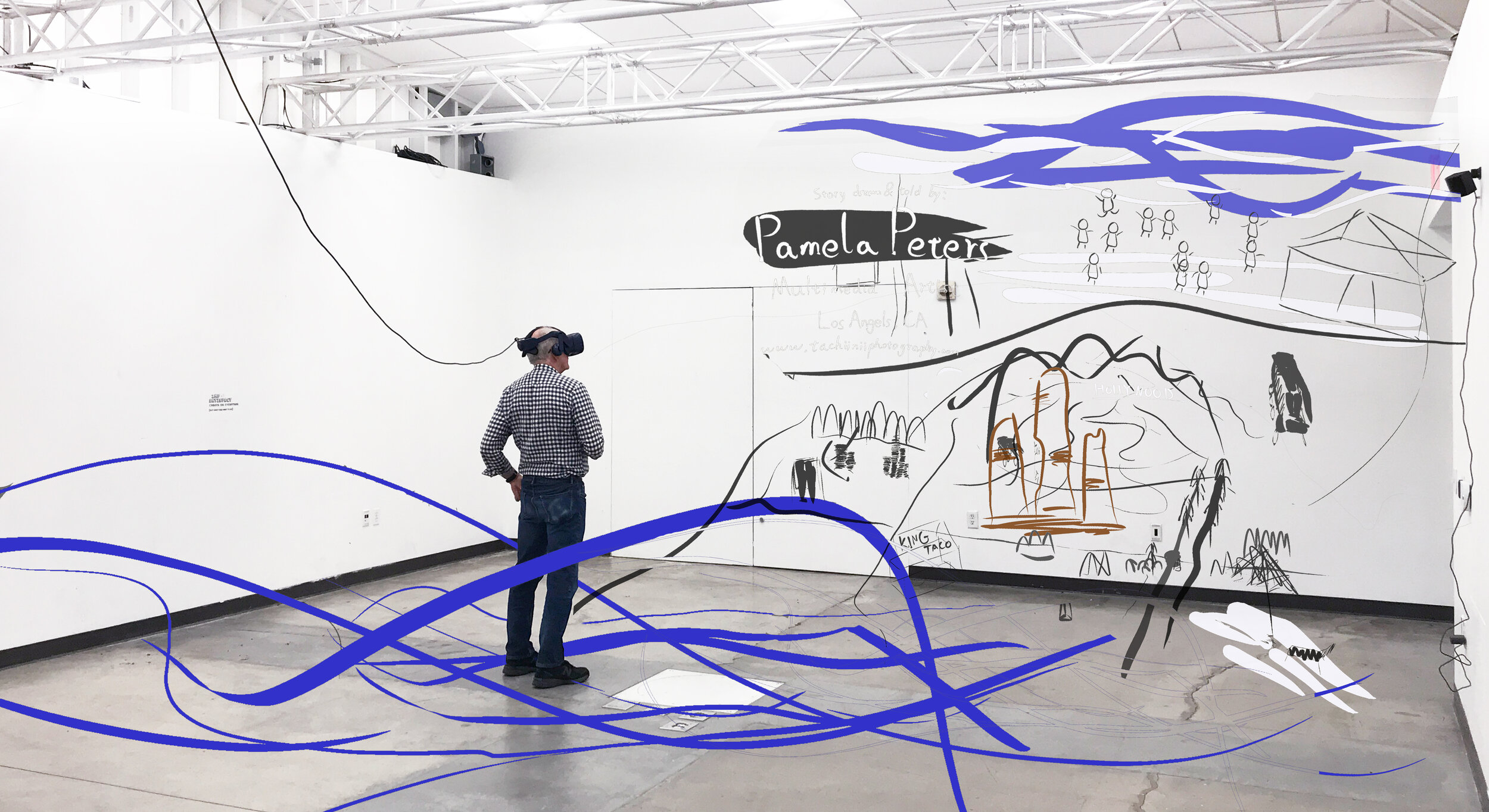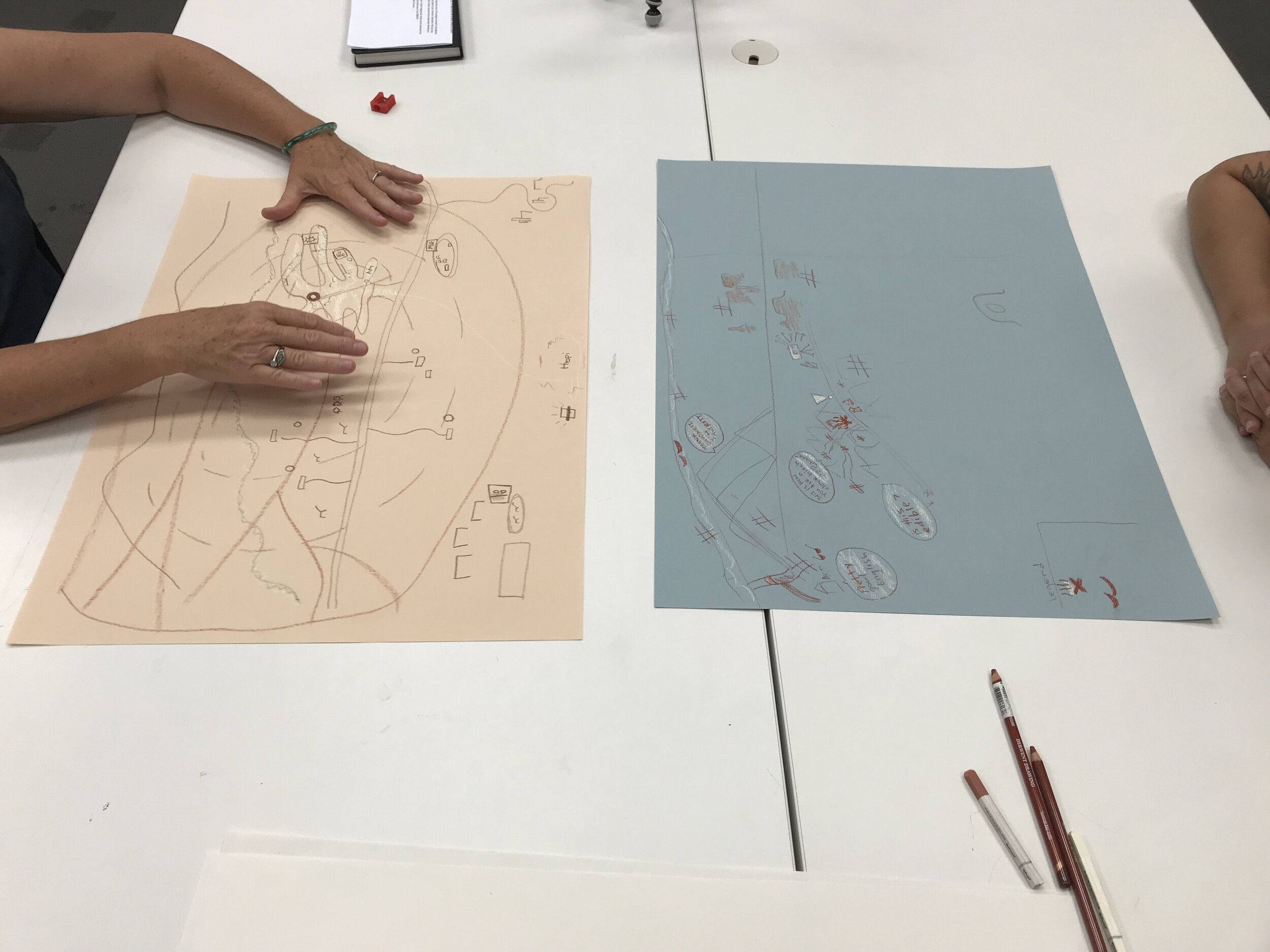Indigenous Autonomy
Design Research, Mixed Reality Design
Summer 2018 Design Internship
Tools: Unity3D, Rhino3D, Photography, Rapid Prototype
My Role: Interview Workshop, Mixed Reality Design, Coding, Modeling
How could immersive experience design help people to empathize with other’s episodic memory?
In Summer 2018, Me and Akash Dhiman worked as design assistants with artist Hans Baumann for the RBMVE-Onward on their exhibition project Indigenous Autonomy. In this project, I was responsible for designing interview workshops and interactive mixed reality exhibitions.
“Indigenous Autonomy is a contemporary response to the 1930’s Rainbow Bridge Monument Valley Expedition and draws from the wealth of archival material accumulated by The ONWARD Project over the course of 15+ years. Through a combination of community outreach, site-based research and cutting-edge VR technology, this project documents contemporary Navajo experiences of Los Angeles and reimagines how cross-cultural exchange can foster social visibility and empower Native voices, places, and stories in the present. In doing so, this project addresses long-standing narratives of marginalization and erasure amongst Native peoples and imagines the role that digital storytelling can play in reframing identity and preserving cultural memory.“ ——Hans Baumann
1. Audience in mixed reality exhibition
2. Story models and the hyper-real gallery space
3. Transition between hyper-real gallery space and Story models
4. Story drawing model from Aaron Yazzie
5. Teleport interaction in mixed reality exhibition
“Upon entering this void space, users would encounter an individual, self-narrating story shared by a Navajo resident of Los Angeles.”
1. Story drawing model from Pamela Peters
2. Story drawing model from Geri Keams
3. Story drawing model from Marlon Footracer
Design Process Overview ————————————————————————————————————————————————————————————————————————————
It was time to learn cultural memory from individuals
Over more than 15 years, the Onward project are dedicated to collected and exhibited digital archives and native resources of historic 1930s expedition about native people and land. This time the Onward project tried to introduced native cultural memory from native individuals to individuals who live in Los Angeles.
The challenges
When it comes to communication of cultural memory, one of the most powerful tools we have is sharing story, especially the story from inner mind that connect between storyteller and audience. But it poses two questions for us:
What is the good story that can create connection between native community and the listener in Los Angeles?
What elements does a good storytelling need to have?
Working with Hans Baumann and Akash Dhiman, we initiated couple conversations with native culture researcher and Navajo archaeologist. For more than three weeks, we have been conducting conversation with different Navajo archaeologists and Navajo people who live in LA to explore what types of thoughts and stories they value most and people might find most appealing.
What makes a good story
Beside the knowledge of native community, we learned some potential elements that makes a story/memory sharing more vivid and precise for both audience and teller during the conversation. So when we start noticing those elements, we follow up with some workshop experiments by inviting team member to share their own story. And try to find out the elements are common features for narrated story sharing. Here are some of the things we looked into:
The main body of story is always the narrative.
The tone from tellers help enrich the story with detail and emotion of each moments.
Good teller tends to find any kind of way to visualize their mental picture, like drawing or using objects on the desk to represent something.
Drawing helps tellers embody the memory they are thinking, and story they are narrating.
Face to face storytelling sometimes make listener awkward. Listener don’t want to show disrespect when they have no interest on the story.
The presence of teller and audience are very important. Listen a story from far way is much different from listen a story on the scene where teller is.
1. Interview and workshop with Ronald P.Maldonado
2. Story sharing experiment with Ronald P.Maldonado
3. Workshop experiment among team member
Help Interviewee tell a good story
We know what is the good story for our project and what kinds of elements that make a good storytelling. The following question become
How can we understand and collect those precious stories from our interviewer respectfully and precisely?
The audience for mixed reality exhibition is Los Angeles resident. The stories are shared by Navajo resident of Los Angeles. But not everyone is a good storyteller and not every story can arouse connection between audience and teller. Therefore, for the interview workshop we focused more on how to evoke emotion through open-end questions and lead our tellers fall into episodic memory about their experience of indigenous identity in Los Angeles. The general workshop flow is:
- Starter
- Relationship between LA and your Home
- For this relationship 3 Meaningful Places/Stories to you
- Choose one to explain what is in your mind and why
Workshop implement
The workshop was designed to create a flow and atmosphere for episodic memory sharing. Those memory should be related to the design topic:
Their own cultural identity memory that related to Los Angeles.
We focused on teller’s life experience between LA and their home. The starters questions: What’re your relationship between LA and your Home? and the abstract following question: Where do you exist? help tellers wander in their memory and narrate without restriction. Along with couple specific questions we try to retrieve the episodic memory through their narrative answer and drawing.
All of above run with a quiet and private space. The focus lighting weakens the influence from recording device on interviewees. In the end, 9 stories were collected successfully with efforts from all of the participants in Navajo Community in Los Angeles. There were 4 selected stories including voice and drawing move ahead to mixed reality exhibition and all of the 9 stories’ drawing were documented and presented on a single 25’ long roll of acetate film.
1. Design draft for workshop flow
2. Navajo native resident Pamela Peters participate in the workshop
3. Drawings from workshop
“This project was centered around a series of workshops in which participants were prompted to share stories of their life in and relationship to Los Angeles, both through drawing and spoken word. ”
——Hans Baumann
Stories need to be transformed
Translate original story from video, audio and drawing to mixed reality representation was part and parcel. We had the chance to create an immersive experience by re-produce the process of 2D-drawing into a 3D imagination world building without re-interpreting the story. The drawing build itself little by little as story narratives goes on. The audience were situated into the center of episodic memory as a time and space anchor where the storyteller was. As part of process, the story owners were invited to come back and review the mixed reality version and help us keep the original expression of their stories.
In 15 mins, audience will have a chance to fully experience one of four stories in this exhibition.
1. Original story drawings
2. 3D imagination story world based on original drawings
3. Animation brief of Aaron Yazzie’s story. Check here for full story.
“Instead of transporting users into an exotic terrain, the VR environment used in this project was an exact replica of the gallery space where the exhibition was held. Users thus encountered an extremely high-resolution facsimile of the room in which they were standing. Navajo stories existed outside the architectural confines of the space and could only be encountered by exiting the representation of the room and entering the infinite void space of the virtual space beyond. ” ——Hans Bauman
Think about the exhibition audience
We know empathy is powerful for understanding personal stories and then realize the culture identity behind it. The great stories we have is the first step. The next step is creating process and narrative to help audience have empathy experience. On average, our audience only have 15 mins to experience the mixed reality exhibition and their range of age from 20 to more than 70. Most of them might be over 50 and don’t have any mixed reality experience.
In a relatively short time, the exhibition needs to help most of our audiences understand, get familiar and enjoy this immersive experience. Limited time, potential older audience, difficulty of create empathy experience. Challenges emerged.
Interactive Mixed Reality Exhibition
Design principles
At a high level, we discovered that presenting a private and unique story memory with immersive technology for audience in a limited time is tough. We also created some design principles to guide our thinking for the rest of the interactive mixed reality exhibition design.
Hyper-real entry
Instead of jump into a virtual story world, audience will encounter the exact replica of the gallery space when they put on VR headset, which create a smooth transition of entering exhibition. The extremely high-resolution facsimile of the room provided mixed sense of reality.
High-resolution model(left) and real room(right)
Working with Eric Hanson, we built a low-res gallery replica as beginning. Based on that, I focused on the parts that audience will notice during much of their experience ——the floor and wall.
Photogrammetry technology was used in this process as well as CAD model rebuild.
1. CAD model rebuilding for gallery room
2. High-res ground rebuild
3. High-res outlet rebuild
Experience process
Coming with the hyper-reality model, audience’s movement in exhibition is only corresponding to their movement in reality at beginning. Physical feeling from the reality like friction and bump are align with what they see. All of these helped audience get used to the mixed reality experience and prepare for the journey. After that, audience will be allowed to use controller to teleport between limited locations, which also allow us to extend experience:
Transition - Exploration - Discovery - Try - Enlightenment
Break through the wall
The way to present the story is not only the story itself but also the process of how we find the story. We want audience to feel the value of the story via this kind of tortuous process. We believe no precious stories should be treated easily and blindly. “Exploration” comes with teleport function when the physical feeling and visual feedback are offset (physical room and virtual room are not aligned any more). Audience need to “search” for stories without any expectation. They need to break barrier by “trying” to break through the hyper-real wall and enter a void space outside the room. Discover the seeds of story and be “enlightened” by the narratives.
Together physical wall and virtual wall create a challenge for audience
Multiple endings
We believe not everyone can break the barrier just like not everyone can actually reach the story. The process of find the story or not just like how we know and value other’s memory in real world. Both finders and no-finders might have some thoughts want to share in the conversation after the exhibition.
What’s next?
The immersive exhibition opened and available on August 2018 in ArtCenter Gallery. It was very successful and had over 30 people try it on. Now I still provide design and technical support for this immersive project for the potential exhibition.




































